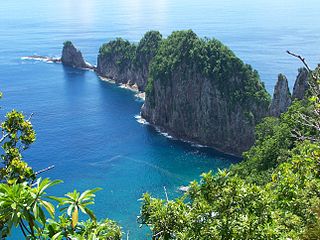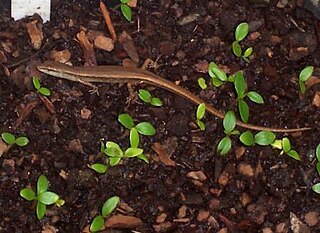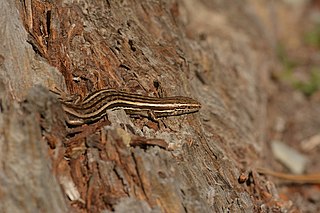
The little owl, also known as the owl of Athena or owl of Minerva, is a bird that inhabits much of the temperate and warmer parts of Europe, the Palearctic east to Korea, and North Africa. It was introduced into Britain at the end of the 19th century and into the South Island of New Zealand in the early 20th century.

Skinks are lizards belonging to the family Scincidae, a family in the infraorder Scincomorpha. With more than 1,500 described species across 100 different taxonomic genera, the family Scincidae is one of the most diverse families of lizards. Skinks are characterized by their smaller legs in comparison to typical lizards and are found in different habitats except arctic and subarctic regions.

René Primevère Lesson was a French surgeon, naturalist, ornithologist, and herpetologist.

The National Park of American Samoa is a national park of the United States located in the territory of American Samoa, distributed across four islands: Tutuila, Ofu, Olosega, and Ta‘ū. The park preserves and protects coral reefs, tropical rainforests, fruit bats, and the Samoan culture. Popular activities include hiking and snorkeling. Of the park's 8,257 acres (3,341 ha), 2,500 acres (1,000 ha) is coral reefs and ocean. The park is the only American National Park Service system unit south of the equator.

The large yellow underwing is a moth, the type species for the family Noctuidae. It is an abundant species throughout the Palearctic realm, one of the most common and most familiar moths of the region. In some years the species is highly migratory with large numbers appearing suddenly in marginal parts of the range.

The lesser yellow underwing is a moth of the family Noctuidae.

Lampropholis delicata, the delicate skink, dark-flecked garden sun skink, garden skink, delicate garden skink, rainbow skink or plague skink, or the metallic skink is native to Australia and invasive in New Zealand and Hawaii where it is commonly found in gardens. The species is known for their color dimorphism between males and females; striped morphs and non-striped morphs exist in this species, however the stripe is less pronounced in males. This species' diet consists of a wide range of prey, such as spiders, bees, larvae, and termites. Mating occurs in the late summer and generally one clutch of 2 to 4 eggs are laid per year by each female.

The McCann's skink is a species of skink native to New Zealand.

Sphenomorphinae is a large subfamily of skinks, lizards within the family Scincidae. The genera in this subfamily were previously found to belong to the Sphenomorphus group in the large subfamily Lygosominae.
Ornithuroscincus albodorsalis is a species of skink found in Papua New Guinea.
Lipinia cheesmanae, also known commonly as Cheesman's lipinia and Cheesman's moth skink, is a species of skink, a lizard in the family Scincidae. The species is endemic to Indonesia.
Ornithuroscincus nototaenia is a species of skink found in Papua New Guinea.
Ornithuroscincus sabini is a species of skink. It is endemic to Milne Bay Province, eastern Papua New Guinea. It is terrestrial to semi-arboreal and has been recorded at elevations of 1,200–2,740 m (3,940–8,990 ft) above sea level.

Ornithuroscincus is a genus of skinks, lizards in the family Scincidae. All but one species are endemic to New Guinea: in addition to northern New Guinea, Ornithuroscincus noctua occurs on many Pacific islands.
Ornithuroscincus bengaun is a species of skink endemic to Milne Bay Province, Papua New Guinea. It is only known from its type locality in the Owen Stanley Range.
Ornithuroscincus inornatus is a species of skink found in Papua New Guinea.
Ornithuroscincus pterophilus is a species of skink found in Papua New Guinea.
Ornithuroscincus viridis is a species of skink. It is endemic to the Owen Stanley Range in the Central Province, southeastern Papua New Guinea. Common name green smooth-eared skink has been coined for it.










